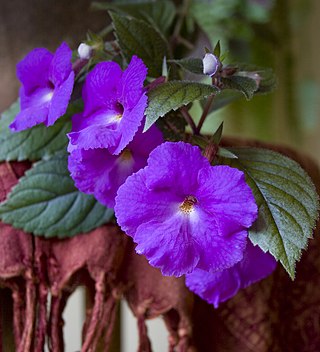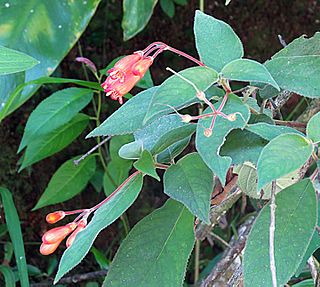
Gesneriaceae, the gesneriad family, is a family of flowering plants consisting of about 152 genera and ca. 3,540 species in the tropics and subtropics of the Old World and the New World, with a very small number extending to temperate areas. Many species have colorful and showy flowers and are cultivated as ornamental plants.

Columnea is a genus of around 200 species of epiphytic herbs and shrubs in the family Gesneriaceae, native to the tropics of the Americas and the Caribbean. The tubular or oddly shaped flowers are usually large and brightly colored – usually red, yellow, or orange – sometimes resembling a fish in shape. A common name is flying goldfish plants due to the unusual flower shape.

Achimenes is a genus of about 25 species of tropical and subtropical rhizomatous perennial herbs in the flowering plant family Gesneriaceae. They have a multitude of common names such as magic flowers, widow's tears, Cupid's bower, or hot water plant.

Kohleria is a New World genus of the flowering plant family Gesneriaceae. The plants are generally tropical herbs or subshrubs with velvety stems and foliage and brightly colored flowers with spots or markings in contrasting colors. They are rhizomatous and commonly include a period of dormancy in their growth cycle. The genus was revised in 1992 and was then recognized as having 19 species distributed in Central America and South America. phylogenetic in 2005 indicated that the epiphytic genus Capanea is derived from within Kohleria, and the two species of Capanea were subsequently transferred to Kohleria. The genus Pearcea is closely related.

Nautilocalyx is a genus of plants in the family Gesneriaceae. Its native range stretches from Costa Rica to southern Tropical America and to Trinidad. It is also found in Bolivia, Brazil, Colombia, Costa Rica, Ecuador, French Guiana, Guyana, Panamá, Peru, Suriname, Trinidad-Tobago and Venezuela.

Paradrymonia is a genus of flowering plants in family Gesneriaceae. It includes 11 species native to the tropical Americas, ranging from Honduras to Bolivia and northern Brazil.

Reldia is a genus of plants in the family Gesneriaceae. They are also in the Beslerieae tribe.
Conrad Vernon Morton was an American botanist, who did notable writings on ferns. He was also a specialist in Gesneriaceae and Solanaceae for the Smithsonian Institution from 1928.
Robert (Louis) Dressler was an American botanist specialist of the taxonomy of the Orchidaceae.

Corytoplectus is a genus in the plant family Gesneriaceae. Plants from Corytoplectus are found in Bolivia, Brazil North, Colombia, Ecuador, Guyana, Mexico Southwest, Peru, Venezuela, in the cloud-forests of the high cordillera. The genus contains c. 12 species. The genus differs from the closely related Alloplectus in having an erect umbellate inflorescence and berries. The type species is C. capitatus.
Trichodrymonia is a genus of flowering plants belonging to the family Gesneriaceae.
Amalophyllon is a genus of flowering plants belonging to the family Gesneriaceae.

Codonanthopsis is a genus of flowering plants in the family Gesneriaceae. Its native range is from southern Mexico through tropical America to Bolivia and most of Brazil. Codonanthopsis species are generally trailing epiphytes with pale flowers. Most have a mutualistic relationship with tree-living ants: the plants provide the ants with food, including nectar, and give their nests structure and support, while the ants disperse the plants' seeds. The genus was considerably expanded in 2013 when species were transferred from Codonanthe. Some Codonanthopsis species are cultivated as houseplants, when they may be grown in hanging baskets.
Cremosperma is a genus of flowering plants belonging to the family Gesneriaceae.
Rufodorsia is a genus of epiphytic flowering plants in the family Gesneriaceae. The genus name refers to the reddish back of the upper lobes of the flower. The relationship of Rufodorsia with the genus Oerstedina is uncertain, as of April 2021. It is native to montane cloud forest in Central America.
Oerstedina is a genus of epiphytic flowering plants in the family Gesneriaceae, native to Mexico, Costa Rica and Panama. The relationship of Oerstedina to the genus Rufodorsia is uncertain, as of April 2021.
Goyazia is a genus of flowering plants belonging to the family Gesneriaceae.
Neomortonia is a monotypic genus of flowering plants belonging to the family Gesneriaceae. It just contains one species, Neomortonia roseaWiehler
Nomopyle is a genus of flowering plants belonging to the family Gesneriaceae.

Moussonia is a genus of plants in the family Gesneriaceae. Its native range stretches from Mexico to Central America. It is found in Costa Rica, El Salvador, Guatemala, Honduras, Mexico and Panamá.










